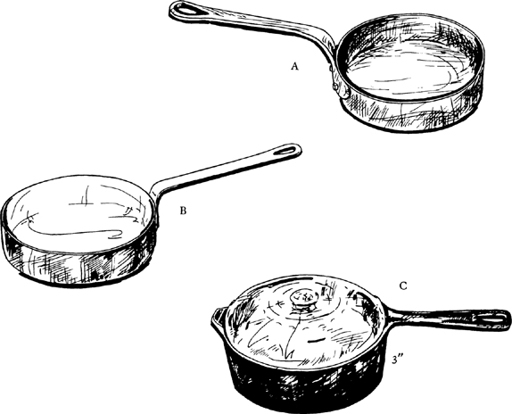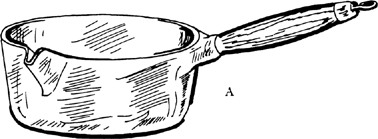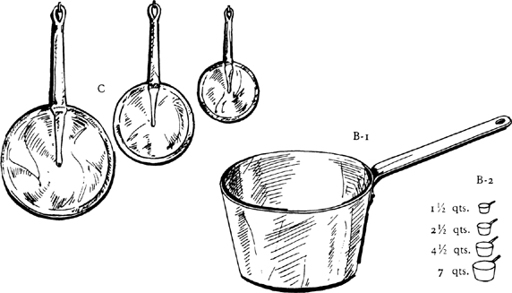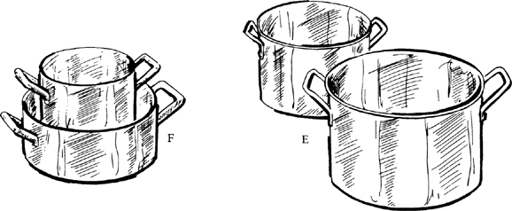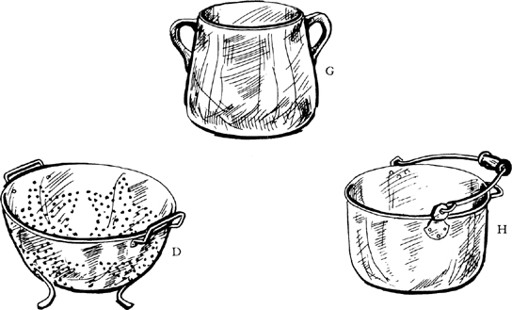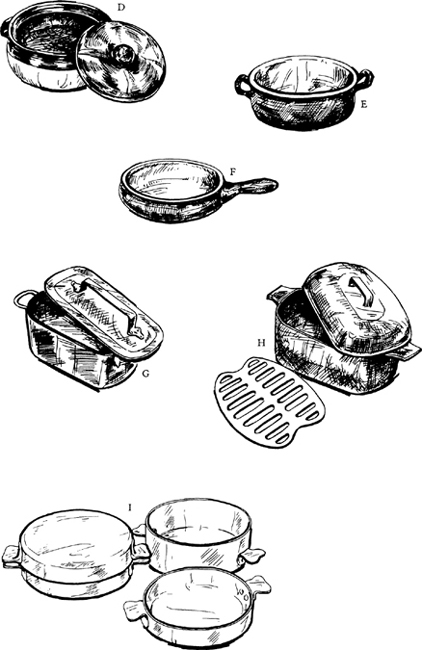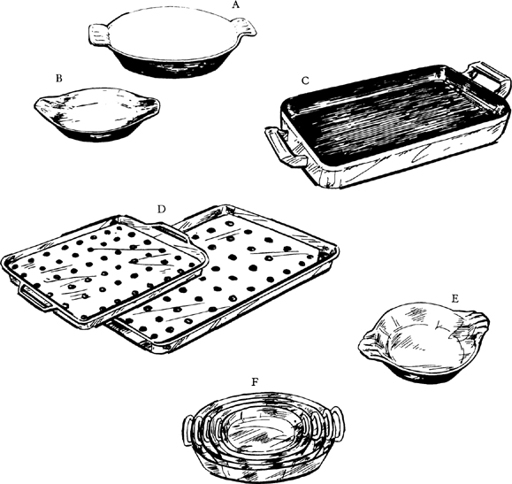Mastering the Art of French Cooking, Volume 2 (219 page)
Read Mastering the Art of French Cooking, Volume 2 Online
Authors: Julia Child

CHICKEN FRYERS
The straight-sided frying pan known as a
sautoir
in French and as a chicken fryer here, is useful, of course, for fried chicken, but it is also good for chicken sautés and fricassees, beef stews, fish stews, and numerous vegetable dishes. Because the cooking usually takes place on top of the stove, it must be of heavy material. The traditional shape (A and B) is typical of the French copper
sautoir
and of the American professional cast aluminum; the sides are 2¼ to 2½ inches high. The deep chicken fryer (C) is of cast iron; this is a fine cooking utensil, but remove foods from it as soon as they are done to prevent discoloration.
SAUCEPANS, KETTLES, COVERS, AND COLANDERS
You will need saucepans (
casseroles
) for sauces and saucepans for general boiling and simmering. When you are cooking with white wine or egg yolks, use a non-staining material like lined copper, stainless steel, flameproof ceramic or glass, or the familiar French enameled cast iron with wooden handle (A).
For boiling potatoes, pasta, and their like, cast aluminum is fine although you will have to scour it from time to time. The professional shape (B-1) is well designed; 1½, 2½, 4½, and 7 quarts (B-2) will give you a reasonable range of pan sizes.
Rather than having a special cover for each pot, a series of long-handled covers allows one to fit several sizes of saucepans (C).
Soup kettles (
marmites
) are essential for
pot-au-feu
, soups,
bouillabaisse
, lobsters, green beans
à la française
, and spinach. An 8-quart kettle and another of 18- to 24-quart capacity would meet most of your needs.
One of them might be the two-handled type (E or F), and another the preserving-kettle type with bucket handle (H). A French earthenware
marmite
(G) is attractive for soups and stews that are cooked and served in the same pot.
A large sturdy
colander is a must; buy one 10 to 11 inches across the top diameter and 5 to 6 inches high, with feet (D).
Casseroles (
cocottes
) can double as saucepans or roasters, and are essential for stews and braises. Enameled ironware is always good because it will go on the stove or into the oven (A, B, C) and foods will not discolor in it; the oval shape is the best if you are limited in space or budget. The American heavy cast-aluminum (H) comes with a removable rack, and in several sizes up to the large turkey roaster. The French
daubière
(G) is in lined copper. Earthenware casseroles (D, E, F) are wonderful for cooking and serving because they spread and retain heat. The attractive copper
cocotte
(I) was designed for the famous potato dish
pommes Anna
, but may be used as a casserole or as two separate baking dishes.
WARNING: All casseroles, baking dishes, plates, pitchers, cups, and other utensils of earthenware, terra cotta, and like materials must be of the high-fired so-called stoneware type, or must otherwise by clearly labeled and certified safe for the cooking and serving of foods and drinks.
GRATIN DISHES AND ROASTING PANS
Flameproof dishes about 2 inches deep are used for baking, gratinéeing, roasting, and serving, and you should have a reasonable number of sizes. Enameled iron gratin dishes (
plats à gratin
) (A and E) are either oval or round, and come from shirred-egg size up to 13 to 14 inches long and 9 inches wide. Earthenware gratin dishes (B) are always attractive for serving. A nest of aluminum dishes (F) is conveniently stored and long lasting. Rectangular enameled iron (C) can be plain or with no-stick interior, and will double for roasting or gratinéeing. Be sure to have a rack (G) that will fit into your large roasting pan so that legs of lamb can be raised out of their juices. If your oven does not come with a perforated rack for the broiling pan (D), buy one separately; otherwise spluttering fat can catch fire while you are doing a steak.
